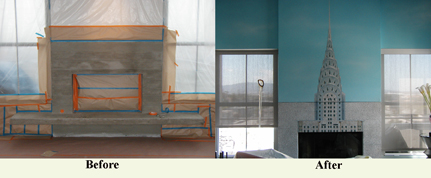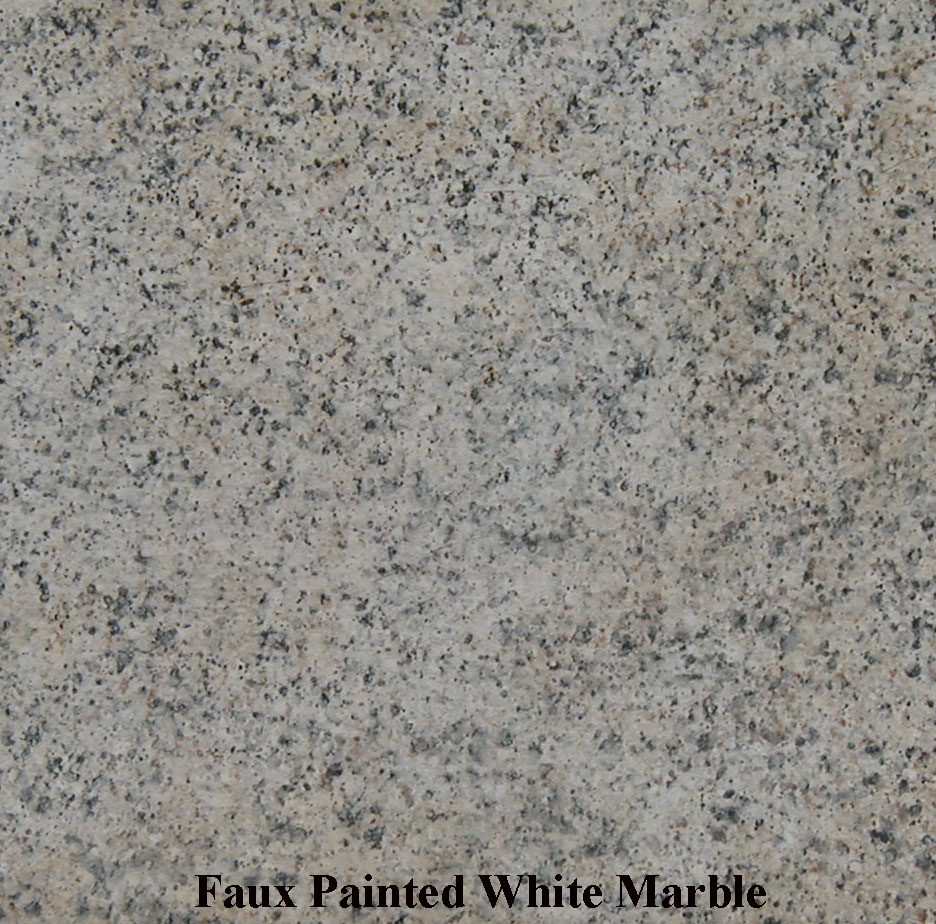Finishing Fireplace Surrounds
Do you have a fireplace surround or mantle that is… well, just there? Is it because you’re not sure what to do with it? Many just leave it because they feel it’s much to costly to replace it, or maybe do not know what options are available. I have written what you can do about stone or brick fireplace surrounds in an article below.
Wood, concrete and pre-cast plaster is common materials used for surrounds. In the above photos, a tile and wood combination are used. I found the stained finish to be rather lifeless and lacking character. I felt the tile was to bright and also lacking interest. The architecture of the home is old world and these finishes missed the mark in my opinion. I felt a stain/paint combination would work best for the décor. To save on cost, I worked directly on the existing finishes. I made up a darker clear acrylic urethane and applied two coats on the mantle and trim molding. This darkened the finish making it look like a dark stain finish. I primed and painted the body. I them applied an aging wash to add a sense of time to the piece. Now it has much more interest than before.
The tile is a pours stone which accepted an acrylic wash. The wash made reducing acrylic paint with water. My goal was to just lose the Newness and look more Old World. This was very easy to do and as the picture demonstrates… a dramatic transformation.
Another material is Concrete or Pre-Cast Plaster. These can be stained or painted to any type of material that is authentic. What I mean is if your surround is very ornate, chances are it would not be made from granite because this material is very hard and difficult to carve. It would most likely be a softer stone like Limestone. When choosing a finish for your surround, be authentic to the design and also to your décor. Will a Brecca marble really go with you architecture and furnishings? I too often see finishes that do not complement the space. This in my opinion this produces tension in your environment rather than creating harmony.
The surround above is a pre-cast plaster. I was previously painted white. I liked the clean look of white but wanted to make it look authentic as well as add texture. I chose a soft limestone finish. This finish is subtle. It has a “feel” about it rather than a visual statement. I feel this type of finish adds to the space on a subliminal level – meaning it’s felt rather than seen – at least at first. You may notice it later but it doesn’t demand your attention.
So you want attention? Well, here is an example. My client is fond of the Chrysler Building in New York. He commissioned me to paint a canvas of the building to hang over the fireplace. I suggested painting the concrete faux white granite.
My client then came up with the idea of painting a portion of the building onto the fireplace to minimize the look of the opening. The thought was to notice the painting rather than the square black hole in the wall. I hired a friend of my Danny Montes to paint the canvas in his shop and I did the rest on site. We hung the canvas and painted the remaining onto the fireplace. It worked. It’s a bit different, but it works for this space.
For more ideas and specialty finishes, please visit my website at: http://dinofauci.com
Tweet









 Copyright © 2010 Dino Fauci Companies, Inc.
Copyright © 2010 Dino Fauci Companies, Inc.
I currently live in a 1928 historic tudor home. I have painted trim and doors in the kitchen. The doors are old and aged and were painted pink. I have properly prepared the doors, washed with TSP, sanded, etc. gave a first coat with Benjamin Moore “Stix”, and now applied Benjamin Moore color “Onyx” with a velour roller to achieve a raised, old wood effect. I would like to age the doors but am at a loss as to how to do this. I would like to apply a aging glaze such as a bronze, but what product and how? If you could help me I would greatly appreciate it. Thanks, Kate
Hello Kate,
Thank you for your inquiry.
First, before I can give you any direction, I need to know what is the story of how these doors became aged, and to what degree of aging (i.e. distressed, sun or water damaged, dirt & grime, or a surface in good condition with a soft patina)? Aging is a story so the storyline (history) needs to be defined. Secondly, a bronze glaze will most likely not add much value over the Onyx since bronze is lighter than the base color. If you are considering a metallic bronze such a Modern Masters acrylic, you are going to get a shimmer which is not really an aging effect. If possible, please send a picture of the door (s) along with more information on the aging story to dino@dinofauci.com and I will do my best to give you clear direction.
Thank you,
Dino